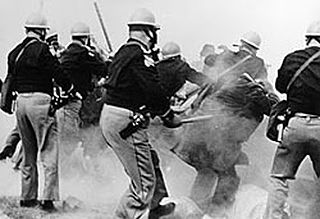Related Research Articles

Lowndes County is in the central part of the U.S. state of Alabama. As of the 2020 census, the county's population was 10,311. Its county seat is Hayneville. The county is named in honor of William Lowndes, a member of the United States Congress from South Carolina.

The Student Nonviolent Coordinating Committee was the principal channel of student commitment in the United States to the civil rights movement during the 1960s. Emerging in 1960 from the student-led sit-ins at segregated lunch counters in Greensboro, North Carolina, and Nashville, Tennessee, the Committee sought to coordinate and assist direct-action challenges to the civic segregation and political exclusion of African Americans. From 1962, with the support of the Voter Education Project, SNCC committed to the registration and mobilization of black voters in the Deep South. Affiliates such as the Mississippi Freedom Democratic Party and the Lowndes County Freedom Organization in Alabama also worked to increase the pressure on federal and state government to enforce constitutional protections.

Kwame Ture was a prominent organizer in the civil rights movement in the United States and the global pan-African movement. Born in Trinidad, he grew up in the United States from the age of 11 and became an activist while attending the Bronx High School of Science. He was a key leader in the development of the Black Power movement, first while leading the Student Nonviolent Coordinating Committee (SNCC), then as the "Honorary Prime Minister" of the Black Panther Party (BPP), and last as a leader of the All-African People's Revolutionary Party (A-APRP).

The Southern Christian Leadership Conference (SCLC) is an African-American civil rights organization based in Atlanta, Georgia. SCLC is closely associated with its first president, Martin Luther King Jr., who had a large role in the American civil rights movement.

The Selma to Montgomery marches were three protest marches, held in 1965, along the 54-mile (87 km) highway from Selma, Alabama, to the state capital of Montgomery. The marches were organized by nonviolent activists to demonstrate the desire of African-American citizens to exercise their constitutional right to vote, in defiance of segregationist repression; they were part of a broader voting rights movement underway in Selma and throughout the American South. By highlighting racial injustice, they contributed to passage that year of the Voting Rights Act, a landmark federal achievement of the civil rights movement.

Ella Josephine Baker was an African-American civil rights and human rights activist. She was a largely behind-the-scenes organizer whose career spanned more than five decades. In New York City and the South, she worked alongside some of the most noted civil rights leaders of the 20th century, including W. E. B. Du Bois, Thurgood Marshall, A. Philip Randolph, and Martin Luther King Jr. She also mentored many emerging activists, such as Diane Nash, Stokely Carmichael, and Bob Moses, as leaders in the Student Nonviolent Coordinating Committee (SNCC).

The March Against Fear was a major 1966 demonstration in the Civil Rights Movement in the South. Activist James Meredith launched the event on June 5, 1966, intending to make a solitary walk from Memphis, Tennessee, to Jackson, Mississippi via the Mississippi Delta, starting at Memphis's Peabody Hotel and proceeding to the Mississippi state line, then continuing through, respectively, the Mississippi cities of Hernando, Grenada, Greenwood, Indianola, Belzoni, Yazoo City, and Canton before arriving at Jackson's City Hall. The total distance marched was approximately 270 miles over a period of 21 days. The goal was to counter the continuing racism in the Mississippi Delta after passage of federal civil rights legislation in the previous two years and to encourage African Americans in the state to register to vote. He invited only individual black men to join him and did not want it to be a large media event dominated by major civil rights organizations.

James Forman was a prominent African-American leader in the civil rights movement. He was active in the Student Nonviolent Coordinating Committee (SNCC), the Black Panther Party, and the League of Revolutionary Black Workers. As the executive secretary of SNCC from 1961 to 1966, Forman played a significant role in the Freedom Rides, the Albany movement, the Birmingham campaign, and the Selma to Montgomery marches.
Gloria Richardson Dandridge was an American civil rights activist best known as the leader of the Cambridge movement, a civil rights action in the early 1960s in Cambridge, Maryland, on the Eastern Shore. Recognized as a major figure in the Civil Rights Movement, she was one of the signatories to "The Treaty of Cambridge", signed in July 1963 with Attorney General Robert F. Kennedy, and state and local officials. It was an effort at reconciliation and commitment to change after a riot the month before.
Annie Bell Robinson Devine (1912–2000) was an American activist in the Civil Rights Movement.
Cleveland "Cleve" Sellers Jr. is an American educator and civil rights activist.

Ruby Doris Smith-Robinson worked with the Student Nonviolent Coordinating Committee (SNCC) from its earliest days in 1960 until her death in October 1967. She served the organization as an activist in the field and as an administrator in the Atlanta central office. She eventually succeeded James Forman as SNCC's executive secretary and was the only woman ever to serve in this capacity. She was well respected by her SNCC colleagues and others within the movement for her work ethic and dedication to those around her. SNCC Freedom Singer Matthew Jones recalled, "You could feel her power in SNCC on a daily basis". Jack Minnis, director of SNCC's opposition research unit, insisted that people could not fool her. Over the course of her life, she served 100 days in prison for the movement.
Black Power is a political slogan and a name which is given to various associated ideologies which aim to achieve self-determination for black people. It is primarily, but not exclusively, used by black people activists and proponents of what the slogan entails in the United States. The Black Power movement was prominent in the late 1960s and early 1970s, emphasizing racial pride and the creation of black political and cultural institutions to nurture, promote and advance what was seen by proponents of the movement as being the collective interests and values of black Americans.

Judy Richardson is an American documentary filmmaker and civil rights activist. She was Distinguished Visiting Lecturer of Africana Studies at Brown University.
Robert "Bob" Mants, Jr. was an American civil rights activist, serving as a field secretary for the Student Nonviolent Coordinating Committee (SNCC). Mants moved to Lowndes County, working for civil rights for the remainder of his life. Lowndes County contained the majority of the distance covered by the 1965 Selma to Montgomery march, and was then notorious for its racist violence.
The Lowndes County Freedom Organization (LCFO), also known as the Lowndes County Freedom Party (LCFP) or Black Panther party, was an American political party founded during 1965 in Lowndes County, Alabama. The independent third party was formed by local African-American citizens led by John Hulett, and by staff members of the Student Nonviolent Coordinating Committee (SNCC) under the leadership of Stokely Carmichael.

Sandra Cason Hayden was an American radical student activist and civil rights worker in the 1960s. Recognized for her defense of direct action in the struggle against racial segregation, in 1960 she was an early recruit to Students for a Democratic Society (SDS). With Student Nonviolent Coordinating Committee (SNCC) in Mississippi, Hayden was a strategist and organizer for the 1964 Freedom Summer. In the internal discussion that followed its uncertain outcome, she clashed with the SNCC national executive.
The Cambridge movement was an American social movement in Dorchester County, Maryland, led by Gloria Richardson and the Cambridge Nonviolent Action Committee. Protests continued from late 1961 to the summer of 1964. The movement led to the desegregation of all schools, recreational areas, and hospitals in Maryland and the longest period of martial law within the United States since 1877. Many cite it as the birth of the Black Power movement.
Muriel Tillinghast is an American civil rights activist and former Student Nonviolent Coordinating Committee (SNCC) field secretary. Her efforts include volunteering for the Freedom Summer Project in Mississippi where she helped start the famed 1964 Freedom School and led Mississippi's Council of Federated Organizations (COFO).

John Robert Zellner is an American civil rights activist. He graduated from Huntingdon College in 1961 and that year became a member of the Student Nonviolent Coordinating Committee (SNCC) as its first white field secretary. Zellner was involved in numerous civil rights efforts, including nonviolence workshops at Talladega College, protests for integration in Danville, Virginia, and organizing Freedom Schools in Greenwood, Mississippi, in 1964. He also investigated the murders of Chaney, Goodman, and Schwerner that summer.
References
- 1 2 3 4 5 6 7 Mitchell, Verner D.; Davis, Cynthia (2019-05-15). Encyclopedia of the Black Arts Movement. Rowman & Littlefield. ISBN 978-1-5381-0146-9.
- ↑ Carmichael, Stokely; Thelwell, Michael; Ture, Kwame; Wideman, John Edgar (2003). Ready for Revolution: The Life and Struggles of Stokely Carmichael (Kwame Ture). Simon and Schuster. ISBN 978-0-684-85003-0.
- ↑ Ford, Tanisha C. (2013). "SNCC Women, Denim, and the Politics of Dress". The Journal of Southern History. 79 (3): 625–658. ISSN 0022-4642. JSTOR 23795090.
- 1 2 Hogan, Wesley C. (2013-01-22). Many Minds, One Heart: SNCC's Dream for a New America. UNC Press Books. ISBN 978-0-8078-6789-1.
- 1 2 Robnett, Belinda (2000-01-13). How Long? How Long?: African American Women in the Struggle for Civil Rights. Oxford University Press. ISBN 978-0-19-976169-2.
- ↑ Drury Smith, Stephen; Ellis, eds., Catherine (2019). Free All Along: the Robert Penn Warren civil rights interviews. New York: The New Press. ISBN 9781595589828.
{{cite book}}:|last2=has generic name (help) - ↑ "Jean Wheeler". SNCC Digital Gateway. Retrieved 2020-06-19.
- ↑ Meyer, David S.; Whittier, Nancy; Robnett, Belinda (2002). Social Movements: Identity, Culture, and the State. Oxford University Press. ISBN 978-0-19-514356-0.
- ↑ Traylor, Eleanor (2014). "Black Arts Fiction: An Introduction". SOS -- Calling All Black People: A Black Arts Movement Reader. University of Massachusetts Press. ISBN 978-1-62534-030-6. JSTOR j.ctt5vk2mr.
- ↑ Washington, Mary Helen (1977). "Teaching Black-Eyed Susans: An Approach to the Study of Black Women Writers". Black American Literature Forum. 11 (1): 20–24. doi:10.2307/3041534. ISSN 0148-6179. JSTOR 3041534.